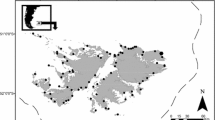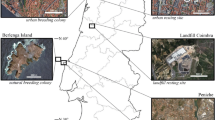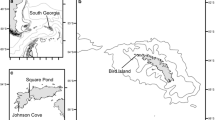Abstract
There was an extraordinary increase in the numbers of European gulls during the twentieth century which has been linked to higher availability of food derived from human activities. At Berlenga island (Portugal), the population of yellow-legged gulls Larus michahellis increased from 2600 individuals to a peak of 44,698 gulls (1974–1994), after which control measures have been put in place. Despite the management effort, little is known about the feeding ecology of this population. To investigate temporal and age-related variations in the diet of yellow-legged gulls at Berlenga, 1668 adult pellets and 145 chick regurgitates were collected and analysed between 2009 and 2012. Contradicting the generally accepted idea that these birds depend mainly on human-related food, adult gulls relied substantially on a locally abundant natural prey, the Henslow’s swimming crab Polybius henslowii. Nevertheless, large amounts of refuse and fish were consumed in periods of apparent lower availability of swimming crabs. Despite the large temporal shifts in diet and feeding areas (change from marine to terrestrial prey), adult gulls consistently provisioned their chicks with a fish-based diet and chick condition remained constant. These results not only highlight the great resilience of this population to changes in food availability but also indicate that food from different human activities remain highly accessible. With the implementation of recent EU legislation regarding the reduction of fishery discards, and the increase of urban populations in the mainland, the monitoring and appropriate management of gull populations will be decisive for the healthy conservation of coastal systems used by these gulls.



Similar content being viewed by others
References
Abdennadher A, Ramírez F, Romdhane MS, Ruiz X, Jover L, Sanpera C (2010) Biomonitoring of coastal areas in Tunisia: stable isotope and trace element analysis in the yellow-legged gull. Mar Pollut Bull 60:440–447
Abdennadher A, Ramírez F, Romdhane MS, Jover L, Sanpera C (2014) Using a three-isotope Bayesian mixing model to assess the contribution of refuse dumps in the diet of yellow-legged gull Larus michahellis. Ardeola 61:297–309
Alonso H, Granadeiro JP, Ramos JA, Catry P (2013) Use the backbone of your samples: fish vertebrae reduces biases associated with otoliths in seabird diet studies. J Ornithol 154:883–886
Álvarez C, Méndez M (1995) Alimentación de la gaviota patiamarilla (Larus cachinnans) en dos localidades costeras asturianas. Chioglossa 1:23–30
Annett C, Pierotti R (1989) Chick hatching as a trigger for dietary switching in the western gull. Colon Waterbirds 12:4–11
Arizaga J, Aldalur A, Herrero A, Cuadrado JF, Mendiburu A, Sanpera C (2011) High importance of fish prey in the diet of yellow-legged gull chicks from the southeast Bay of Biscay. Seabird 23:1–6
Arizaga J, Jover L, Aldalur A, Cuadrado JF, Herrero A, Sanpera C (2013) Trophic ecology of a resident yellow-legged gull (Larus michahellis) population in the Bay of Biscay. Mar Environ Res 87–88:19–25
Arizaga J, Aldalur A, Herrero A, Cuadrado JF, Díez E, Crespo A (2014) Foraging distances of a resident yellow-legged gull (Larus michahellis) population in relation to refuse management on a local scale. Eur J Wildl Res 60:171–175
Atlas E (2008) Atlas das aves nidificantes em Portugal (1999–2005). Assírio & Alvim, Lisboa
Belant JL (1997) Gulls in urban environments: landscape-level management to reduce conflict. Landsc Urban Plan 38:245–258
Bicknell AW, Oro D, Camphuysen KC, Votier SC (2013) Potential consequences of discard reform for seabird communities. J Appl Ecol 50:649–658
Borges TC, Erzini K, Bentes L, Costa ME, Gonçalves JMS, Lino PG, Pais C, Ribeiro J (2001) By-catch and discarding practices in five Algarve (southern Portugal) métiers. J Appl Ichthyol 17:104–114
Bosch M, Oro D, Cantos FJ, Zabala M (2000) Short-term effects of culling on the ecology and population dynamics of the yellow-legged gull. J Appl Ecol 37:369–385
Bukacińska M, Bukaciński D, Spaans AL (1996) Attendance and diet in relation to breeding success in herring gulls (Larus argentatus). Auk 113:300–309
Bukaciński D, Bukacińska M, Spaans AL (1998) Experimental evidence for the relationship between food supply, parental effort and chick survival in the lesser black‐backed gull Larus fuscus. Ibis 140:422–430
Cabral H, Duque J, Costa MJ (2003) Discards of the beach seine fishery in the central coast of Portugal. Fish Res 63:63–71
Catry P, Costa H, Elias G, Matias R (2010) Aves de portugal: ornitologia do território continental. Assírio & Alvim, Lisboa
Ceia FR, Paiva VH, Fidalgo V, Morais L, Baeta A, Crisóstomo P, Mourato E, Garthe S, Marques JC, Ramos JA (2014) Annual and seasonal consistency in the feeding ecology of an opportunistic species, the yellow-legged gull Larus michahellis. Mar Ecol Prog Ser 497:273–284
Cramp S, Simmons KEL (1983) The birds of the western palearctic, vol 3. Oxford University Press, Oxford
Duhem C, Vidal E, Legrand J, Tatoni T (2003) Opportunistic feeding responses of the yellow-legged gull Larus michahellis to accessibility of refuse dumps: the gulls adjust their diet composition and diversity according to refuse dump accessibility. Bird Study 50:61–67
Duhem C, Vidal E, Roche P, Legrand J (2005) How is the diet of yellow-legged gull chicks influenced by parent’s accessibility to landfills? Waterbirds 28:46–52
Duhem C, Roche P, Vidal E, Tatoni T (2008) Effects of anthropogenic food resources on yellow-legged gull colony size on Mediterranean islands. Popul Ecol 50:91–100
Fernandes AC, Pérez N, Prista N, Santos J, Azevedo M (2015) Discards composition from Iberian trawl fleets. Mar Policy 53:33–44
Furness RW, Ensor K, Hudson AV (1992) The use of fishery discards by gull populations around the British isles. Ardea 80:105–113
González-Gurriarán E (1987) El patexo, polybius henslowii leach (decapoda, brachyura), en las costas de galicia (NW de españa): I. Distribución espacial y cambios temporales. Investig Pesq 51:361–374
González-Solís J, Oro D, Pedrocchi V, Jover L, Ruiz X (1997a) Bias associated with diet samples in Audouin’s gulls. Condor 99:773–779
González-Solís J, Ruiz X, Jover L (1997b) Influence of food availability on interactions between Larus cachinnans and L. Audouinii. Can J Zool 75:719–724
Hamer KC, Furness RT, Caldow RWG (1991) The effects of changes in food availability on the breeding ecology of great skuas catharacta skua in Shetland. J Zool 223:175–188
Harris MP (1970) Rates and causes of increases of some British gull populations. Bird Study 17:325–335
Heath MR, Cook RM, Cameron AI, Morris DJ, Speirs DC (2014) Cascading ecological effects of eliminating fishery discards. Nat Commun 5:3893. doi:10.1038/ncomms4893
Leitão F, Baptista V, Zeller D, Erzini K (2014) Reconstructed catches and trends for mainland Portugal fisheries between 1938 and 2009: implications for sustainability, domestic fish supply and imports. Fish Res 155:33–50
Louzao M, Arcos JM, Guijarro B, Valls M, Oro D (2011) Seabird-trawling interactions: factors affecting species-specific to regional community utilisation of fisheries waste. Fish Oceanogr 20:263–277
Luis AMS (1982) A avifauna da ilha Berlenga com especial referência à biologia de Larus argentatus. Universidade de Lisboa, Portugal BSc thesis
Martínez-Abraín A, González-Solís J, Pedrocchi V, Genovart M, Abella JC, Ruiz X, Jiménez J, Oro D (2003) Kleptoparasitism, disturbance and predation of yellow-legged gulls on Audouin’s gull in three colonies of the western Mediterranean. Sci Mar 67:89–94
Matias R, Catry P (2010) The diet of Atlantic yellow-legged gulls (Larus michahellis Atlantis) at an oceanic seabird colony: estimating predatory impact upon breeding petrels. Eur J Wildl Res 56:861–869
Mitchell PI, Newton SF, Ratcliffe N, Dunn TE (2004) Seabird populations of Britain and Ireland. T & AD Poyser, London
Morais L, Casanova A (2008) Nidificação de gaivota-de-patas-amarelas (larus michahellis) na cidade de peniche, portugal. Airo 18:29–33
Morais L, Vicente L (1998) Espectro alimentar dos juvenis não voadores de larus cachinnans da ilha da berlenga. Airo 9:59–60
Morais L, Santos C, Vicente L (1998) Population increase of yellow-legged gulls Larus cachinnans breeding on berlenga island (Portugal), 1974–1994. Sula 12:27–37
Morais L, Robb M, Nunes M, Crisóstomo P, Mourato E (2014) Notícias breves da ilha da berlenga: a gaivota-de-patas-amarelas larus michahellis, os migradores e o roque-de-castro oceanodroma castro. In: SPEA (ed) Livro de resumos do VIII congresso de ornitologia da SPEA. Sociedade Portuguesa para o Estudo das Aves, Lisboa
Moreno R, Jover L, Munilla I, Velando A, Sanpera C (2010) A three-isotope approach to disentangling the diet of a generalist consumer: the yellow-legged gull in northwest Spain. Mar Biol 157:545–553
Munilla I (1997a) Henslow’s swimming crab (Polybius henslowii) as an important food for yellow-legged gulls (Larus cachinnans) in NW Spain. ICES J Mar Sci 54:631–634
Munilla I (1997b) Estudio de la población y ecologia trófica de la gaviota patiamarilla (Larus cachinnans) en Galicia. Universidade de Santiago de Compostela, Spain PhD thesis
Nogales M, Zonfrillo B, Monaghan P (1995) Diets of adult and chick herring gulls Larus argentatus argenteus on Alisa Graig, south-west Scotland. Seabird 17:56–63
Oro D, Martínez-Abraín A (2007) Deconstructing myths on large gulls and their impact on threatened sympatric waterbirds. Anim Conserv 10:117–126
Oro D, Bosch M, Ruiz X (1995) Effects of a trawling moratorium on the breeding success of the yellow-legged gull Larus cachinnans. Ibis 137:547–549
Oro D, de León A, Mínguez E, Furness RW (2005) Estimating predation on breeding european storm-petrels (hydrobates pelagicus) by yellow-legged gulls (Larus michahellis). J Zool 265:421–429
Pedrocchi V, Oro D, González-Solís J (1996) Differences between diet of adult and chick Audouin’s Gulls Larus audouinii at the Chafarinas islands, SW Mediterranean. Ornis Fenn 73:124–130
Pierotti R, Annett CA (1991) Diet choice in the herring gull: constraints imposed by reproductive and ecological factors. Ecology 72:319–328
Pons JM (1992) Effects of changes in the availability of human refuse on breeding parameters in a herring gull Larus argentatus population in Brittany, France. Ardea 80:143–150
R Development Core Team (2010) R: a language and environment for statistical computing (2.10.1). R Foundation for Statistical Computing, Vienna
Ramos R, Ramirez F, Jover J, Ruiz X (2009) Diet of yellow-legged gull (Larus michahellis) chicks along the Spanish Western Mediterranean coast: the relevance of refuse dumps. J Ornithol 150:265–272
Rock P (2005) Urban gulls. Br Birds 98:338–355
Ronconi RA, Steenweg RJ, Taylor PD, Mallory ML (2014) Gull diets reveal dietary partitioning, influences of isotopic signatures on body condition, and ecosystem changes at a remote colony. Mar Ecol Prog Ser 514:247–261
Rotheray GE (1993) Colour guide to hoverfly larvae (Diptera, Syrphidae) in Britain and Europe. Dipterists Dig 9:1–156
Sardà F, Coll M, Heymans JJ, Stergiou KI (2013) Overlooked impacts and challenges of the new European discard ban. Fish Fish 16:175–180
Schwemmer P, Garthe S (2005) At-sea distribution and behaviour of a surface-feeding seabird, the lesser black-backed gull Larus fuscus, and its association with different prey. Mar Ecol Prog Ser 285:245–258
Schwemmer H, Schwemmer P, Ehrich S, Garthe S (2013) Lesser black-backed gulls (Larus fuscus) consuming swimming crabs: an important link in the food web of the southern north Sea. Estuar Coast Shelf Sci 119:71–78
Sol D, Arcos JM, Senar JC (1995) The influence of refuse tips on the winter distribution of yellow-legged gulls Larus cachinnans. Bird Study 42:216–221
Sousa P, Azevedo M, Gomes MC (2005) Demersal assemblages off Portugal: mapping, seasonal, and temporal patterns. Fish Res 75:120–137
Steenweg RJ, Ronconi RA, Leonard ML (2011) Seasonal and age-dependent dietary partitioning between the great black-backed and herring gulls. Condor 113:795–805
Stenhouse IJ, Montevecchi WA (1999) Indirect effects of the availability of capelin and fishery discards: gull predation on breeding storm-petrels. Mar Ecol Prog Ser 184:303–307
Talmat-Chaouchi N, Boukhemza M, Moulai R (2014) Comparative analysis of the yellow-legged gull’s (Larus michahellis (Naumann, 1840)) trophic ecology in two colonies of the central coast of Algeria. Zool Ecol 24:324–331
Thomas GJ (1972) A review of gull damage and management methods at nature reserves. Biol Conserv 4:117–127
Tuset VM, Lombarte A, Assis CA (2008) Otolith atlas for the western Mediterranean, north and central eastern Atlantic. Sci Mar 72:7–198
Valeiras J (2003) Attendance of scavenging seabirds at trawler discards off Galicia, Spain. Sci Mar 67:77–82
Vidal E, Medail F, Tatoni T (1998) Is the yellow-legged gull a superabundant bird species in the Mediterranean? impact on fauna and flora, conservation measures and research priorities. Biodivers Conserv 7:1013–1026
Votier SC, Bearhop S, MacCormick A, Ratcliffe N, Furness RW (2003) Assessing the diet of great skuas, Catharacta skua, using five different techniques. Polar Biol 26:20–26
Watanuki Y (1992) Individual diet difference, parental care and reproductive success in slaty-backed gulls. Condor 94:159–171
Acknowledgments
The authors are grateful to Reserva Natural da Berlenga and ICNF for granting permission to work on the island and to Lurdes Morais, Paulo Crisóstomo and Eduardo Mourato who gave important logistical support to carry out the work at Berlenga. They are grateful to all who gave them valuable help in the fieldwork, namely Ricardo Rocha and Penelope Karagianni. They also thank Paula Cristina Ramalho, from the Direcção-Geral de Recursos Naturais, Segurança e Serviços Marítimos, who provided landing data of fishing vessels operating in the Peniche area. Cristobal Pérez, Miguel Lecoq and Pedro Geraldes kindly provided access to key literature. They also thank Nuno Barros for the helpful comments on interactions of gulls with purse seiners. This study was financed by Fundação para a Ciência e Tecnologia (FCT-Portugal) through a doctoral fellowship to H. Alonso (BD/47055/2008) and projects PTDC/MAR/121071/2010 and IF/00502/2013/CP1186/CT0003.
Author information
Authors and Affiliations
Corresponding author
Additional information
The authors wish it to be known that, in their opinion, Hany Alonso and Ana Almeida should be regarded as Joint First Authors.
Electronic supplementary material
Below is the link to the electronic supplementary material.
ESM. 1
(PDF 71 kb)
Rights and permissions
About this article
Cite this article
Alonso, H., Almeida, A., Granadeiro, J.P. et al. Temporal and age-related dietary variations in a large population of yellow-legged gulls Larus michahellis: implications for management and conservation. Eur J Wildl Res 61, 819–829 (2015). https://doi.org/10.1007/s10344-015-0958-9
Received:
Revised:
Accepted:
Published:
Issue Date:
DOI: https://doi.org/10.1007/s10344-015-0958-9




